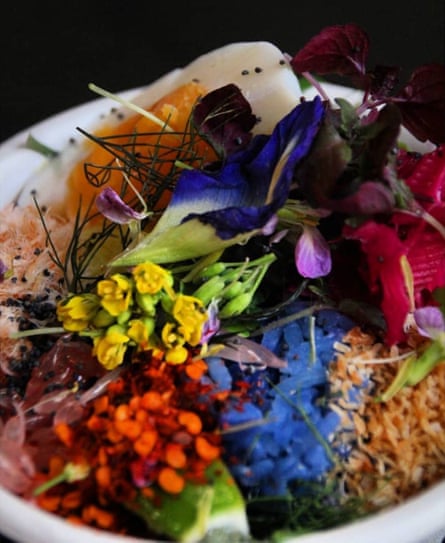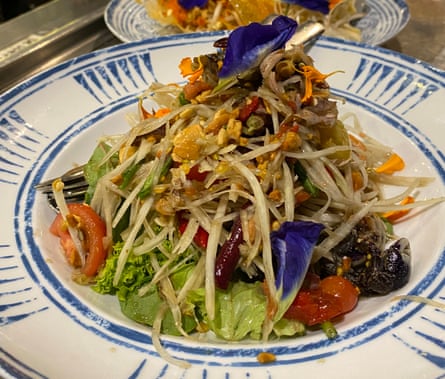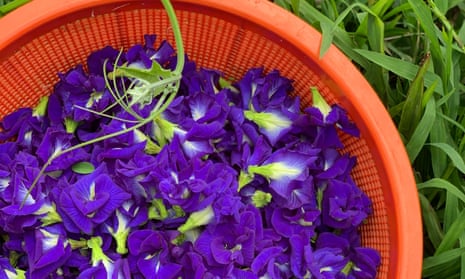At the start of a new year, or decade, I can never guess how I will feel by the end of it. We might give rough estimations about how we’ll evolve, setting ambitions and goals. But we can never see the future clearly.
The one certainty I have is that I will continue to practice regenerative agriculture. My goal is to move towards self-sufficiency in my food sources. It is how I can ensure I have access to exactly what I want to eat and serve. Growing food is also addictive, challenging (especially now when it is incredibly dry) and highly fulfilling.
Choosing varieties that match the climate is key for successful growing. But on our subtropical farm, where the weather can veer temperate or tropical depending on the season, we have been able to grow almost anything. So I try almost everything.
The blue butterfly pea is one of these experiments. It’s a crop I’d grown in Sydney, where it thrived during the summer, but even in the mildest winter it would die without fail, with no hope for resurrection.

The seeds went in three years ago here in Arakwal country. The vines continue to flourish and the flowers loom larger and larger with each new flush as the plant matures.
Clitoria ternatea is glorious, with an appearance that lives up to its Latin name. The flowers of this leguminous plant have long been used in cooking and Ayurvedic medicine, all throughout south-east Asia and the Middle East. Proponents of its medicinal powers claim it can give you better vision and blood circulation, improve your mood, increase your sex drive and even make you think more clearly.
It can certainly amuse your kids endlessly with its natural blue food colouring.
Growing up, in Thai culinary culture, I didn’t care about its nutritional qualities. It was just the flower that made all the food a fun and beautiful hue of peacock blue. Then, with the addition of an acid, purple. As if by magic.

I just love looking at its ethereal bloom, the iridescent petals ignite a deep response inside my core.
Recently I discovered that in Queensland they have been using blue butterfly pea as a successful cover crop and for cattle fodder. The peas are extremely high in protein and their prolific yield makes it excellent feed. It’s marvellously drought tolerant and an outstanding nitrogen fixer, improving the soil nutrient content around where it grows. On top of all this, it creates a captivating habitat for pollinators – there is always a swarm of beneficial insects around it.
Infusing the flowers in cold water or making it a tea with other aromatic herbs like lemongrass and pandan is an easy way to drink it.
Traditionally, the flowers have been used to colour rice, tapioca and flours, but I have been seeing it pop up in lattes, muffins and used in other creative ways.
At Chat Thai we adorn our som dtum green papaya salad with its scattered petals. Flavour-wise it is neutral and very palatable, so works well with something acidic. As a purist, this is my favourite way to use this elegant flower – exactly as it is.
It seems felicitous that going into 2020 the blue butterfly pea is my totem plant. I am certain it is not just a passing trend. And perhaps since I am nearing my 40s, as in its ancient medicinal uses, it can help keep me seeing clearly.
Chat Thai’s som dtum

Serves 2
5 fresh blue butterfly pea flowers, depetalled
150g hard green papaya
2 tbs palm sugar, softened
3 garlic cloves
2 red birds eye chilli
1 tbs dry roasted peanuts
A handful of snake beans, cut into 3cm batons
1tbs good quality dried shrimps
4 halved organic cherry or grape tomatoes
2 tbs red boat fish sauce
3 tbs fresh organic lime juice
Using a Kiwi brand vegetable peeler (the crimped one is especially designed for green papaya), peel the outer hard green skin off the papaya, then lightly shred 10cm threads into a bowl of cold water. Rinse the shredded papaya a few times until the water runs clear. Drain and refrigerate.
With deep earthen clay mortar and pestle, grind palm sugar, garlic and chilli into a rough paste.
Add peanuts, green beans and dried shrimps. Pound until slightly crushed and flattened. Do not eviscerate!
Add halved tomatoes and gently crush until they just omit juice, but keep them intact.
Season with fish sauce and lime juice. Using a large metal spoon mix thoroughly until the seasoning is well incorporated and the palm sugar is completely dissolved into the liquid.
Add the shredded papaya straight out of the refrigerator into the mortar and, using the large metal spoon and pestle, lightly toss and carefully bruise until the papaya is coated with the juices and the pieces are equally dispersed through the salad.
Scoop the salad out of the mortar into a shallow rimmed plate, scatter with the blue butterfly pea flower petals and serve immediately.

Comments (…)
Sign in or create your Guardian account to join the discussion